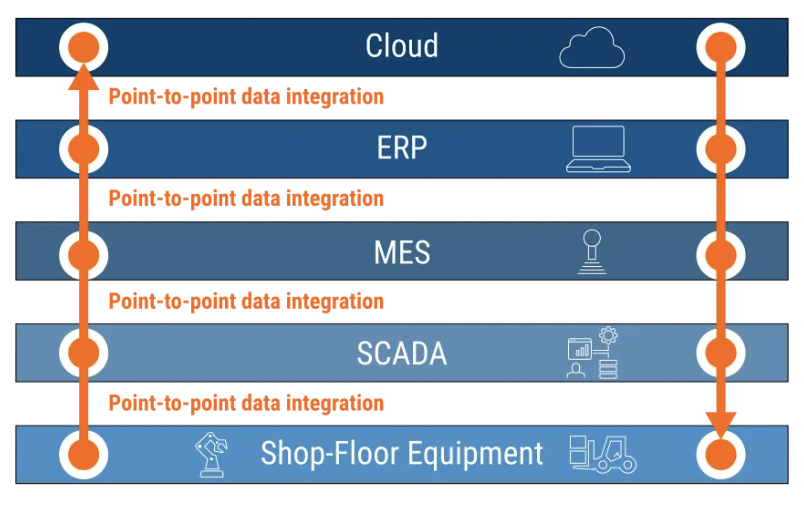Industrial IoT (IIoT) really means making industrial devices work together so they can communicate better for the sake of ultimately improving data analytics, efficiency, and productivity.
But in IIoT, as in other industries, data silos are a huge issue. If your data lives in silos, you’re not making the most of it.
Unified Namespace (UNS) plays a key role in making IIoT work well — ie, affordably and efficiently – by eliminating data silos and bringing together under one roof all the data from all your IIoT components, including supervisory control and data acquisition (SCADA), MES, cloud, and ER. so that they can communicate using IIoT protocols like MQTT.
Read on to learn what UNS is, why it’s important, how it works, and the technologies you need to optimize your UNS.
Table Of Contents
The Unified Namespace Imperative
Every year, organizations collectively lose $3.1 trillion due to data silos — which contain as much as 40% of business-critical information.
When important data isn’t accessible across the organization, companies can’t make the best decisions. Work slows down, too, since employees can’t find information easily; one report found that the average worker spends 12 hours a week trying to track down data. For a company with 100 employees, multiply that over the course of the year, and you’re looking at upwards of 60,000 hours wasted.
Which begs the question: What could your company accomplish with an extra 7,500 eight-hour shifts each year?
Unfortunately, siloed data isn’t the only problem holding organizations back. According to a recent study, 77% of companies are facing data quality issues. When companies can’t trust their data, decision-making is delayed — assuming the organization doesn’t use inaccurate data to inform their path forward.
To shatter data silos, improve data quality, and otherwise transform into a truly data-driven operation, more and more organizations are prioritizing UNS investments.
What is Unified Namespace?
UNS is a centralized data framework that aggregates information from multiple sources and blends it all together, ensuring consistency, accuracy, and a single source of truth.
By deploying UNS, organizations can shatter data silos while improving data quality. At the same time, they can also ensure that all data is accessible in real time, regardless of its original location or format.
As a result, UNS enhances consistency, accelerates operational optimization, and improves data accessibility — which, in turn, streamlines operations across the organization and supports smarter decision-making.
UNS is particularly helpful for integrating data from machinery, production lines, sensors, and ERP systems, thus providing a viable approach to achieve IT-OT data convergence.
How does Unified Namespace work?
When organizations implement UNS, they create a virtual layer that brings disparate data systems together, accessible via one interface.
Typically, this involves using software and data virtualization tools to aggregate data from different databases, applications, and storage repositories. Once deployed, UNS continuously syncs and updates data in real time, ensuring that all users and applications have access to the most current information.
By providing an interface where all organizational data is accessible, data silos and data discrepancies are eliminated, enabling accurate data to flow through the organization unimpeded providing the same version of truth across applications.
Historically, manufacturing organizations have relied on traditional industrial architectures to store, transmit, and manage data. In these hierarchical architectures, data flows in a linear, top-down manner. Each level of the hierarchy — from sensors to control systems to enterprise systems — operates in its own silo, with data often being collected, analyzed, and stored independently.

In addition to data silos, this old-school approach led to many other shortcomings, including:
- Latency issues, since data transfers across different levels of the hierarchy can be slow, preventing real-time decision-making;
- Inconsistent data, with different systems creating data using various formats and standards, leading to discrepancies and inaccuracies;
- Complex integration while integrating new systems, which can be cumbersome and costly; and
- Limited scalability, which prevents organizations from leveraging advanced analytics and IoT technologies with any sense of urgency.
Benefits of Unified Namespace
UNS addresses the shortcomings inherent in traditional industrial architecture by providing a centralized framework that consolidates all data into a central view. As a result, organizations that use a UNS enjoy several transformative benefits.
Shattered data silos
UNS breaks down data silos by integrating information from all sources into a single, unified repository, giving organizations end-to-end visibility into all of their data. This seamless integration allows organizations to perform comprehensive analyses, leading to more informed, more accurate decision-making. By having all data accessible in one place, stakeholders can easily share information across departments and systems, eliminating the fragmentation that often slows collaboration and efficiency in traditional architectures.
Real-time data access
UNS ensures that data is continuously synced and updated in real time, making up-to-date information readily available to users, systems and processes. This real-time access significantly enhances operational responsiveness, allowing businesses to quickly react to changes, identify issues, and optimize processes on the fly. With the most current data at their fingertips, organizations can make faster, more effective decisions — both human-driven and automated — improving organizational agility and enjoying better business outcomes because of it.

UNS architecture (Source: HiveMQ)
Improved data consistency
By harmonizing data formats and standards across various systems, UNS improves data consistency and reliability. This standardization ensures that all departments and systems are working with the same accurate information, reducing errors and discrepancies. As a result, decision-makers can trust the data they use, leading to more efficient operations and lower costs.
Simplified integration
The flexible architecture of a UNS simplifies the integration of new systems, applications, and technologies. Unlike traditional architectures — where adding or updating systems can be complex, costly, and even impossible — UNS allows organizations to easily incorporate new technologies into their infrastructure, with the prerequisite that the new system will keep the UNS updated. This adaptability supports continuous improvement and scalability, enabling organizations to keep pace with the evolution of technology and future-proof their data strategies.
Increased scalability
By supporting the addition of advanced analytics, IIoT devices, and other technologies, UNS makes it easier for organizations to scale operations. As businesses grow, UNS provides the groundwork that enables them to accommodate new data sources and increase workloads without disruption. This scalability ensures that organizations can continue to innovate and expand their capabilities seamlessly, without missing a step.
Deploying Unified Namespace: Key Considerations
When deploying UNS, there are some key considerations to keep top of mind to increase your chances of success.
Data integration
Ensuring seamless integration of all data sources is critical when it comes to succeeding with a UNS deployment. As you begin rolling out a UNS, consider the compatibility of various systems and data formats to ensure you end up with a cohesive environment on the back end. Proper data integration ensures that all relevant data is accessible and usable within the UNS, enabling accurate and comprehensive insights.
Real-time data syncing
Making the most out of your UNS requires real-time data syncing to ensure that all information is accurate and up to date at all times. For this reason, it’s important to establish reliable syncing mechanisms that prevent delays or discrepancies in data. This ensures that decisions are based on the most current information, improving operational efficiency and effectiveness.
Scalability
Planning for future scalability is key to a successful UNS deployment. For the best results, your system should be able to accommodate new technologies, data sources, and growing workloads without disruption. By designing your system with scalability in mind, you can expand your operations smoothly while continuing to leverage the benefits of a UNS as you grow your business.
Security
Whenever you’re designing data architecture, security needs to be top of mind. As you roll out your UNS, it’s critical to implement strong security measures to keep your sensitive data protected in transit and in storage. While you’re at it, you also need to deploy granular access controls to ensure only authorized users can access critical data. By devising a robust security framework, you can maintain the integrity of your data while protecting your crown jewels from bad actors.
Flexibility
To ensure you can accommodate additional systems in the future, it’s important to choose a flexible architecture for your UNS. Ideally, the architecture will allow for easy integration of new technologies and evolving business needs. This, in turn, ensures that your UNS can adapt to meet organizational demands as they change.
Employee training
To unlock the full potential of an UNS, you need to provide adequate training for all employees so that they can learn how to use the new technology effectively. Training should cover how to access, analyze, and manage data within the new environment. Since well-trained employees are more likely to adopt the new system compared to folks who have no idea how to use it, employee training is crucial when it comes to maximizing the benefits of the UNS.
Why Optimizing Your UNS Requires a Real-Time Data Platform
To maximize your UNS investment, you need a real-time data platform capable of handling the increased data flow rate from all integrated data sources and the increased usage of the data across the organization. That way, you can ensure that every part of the organization is working with the most current information available.
Real-time data access is critical for making timely, data-driven decisions and maintaining operational efficiency. Without a real-time data platform, the purpose of the UNS is defeated because the technology would struggle to provide accurate and consistent data that’s up to date — leading to delays and potential errors in the decision-making process.
Learn more about how enabling quick, intelligent decisions on real-time data will enable your UNS deployment.




